 |
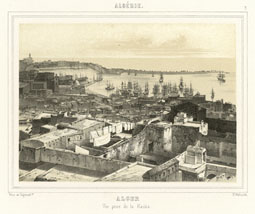
 |
 |
Algiers, Taken from the Casbah, in Vues d'Algérie prises au dauguerréotype, 1847
|
 |
The city of Algiers, on the north coast of Africa, historically sheltered a diverse population. During the Ottoman centuries (1529–1830), this semi-independent province was home to Arabs, Berbers, black Africans, Jews, Turks, and kulughli (offspring of Turkish soldiers and Algerian women).
When the French occupied Algiers in 1830, they transformed the city. There was an influx of settlers from France, as well as southern Italy and Spain. European norms and the French system of governance were imposed. The land was mapped, its peoples surveyed and classified. The "Arab" city on the hillside, known as the Casbah, was separated from the "French" or "European" city that spread out in districts below and around the Casbah. This division, engraved into the spaces of Algiers, endured during the 132 years of French rule ending with the War of Independence (1954–1962).
Walls of Algiers examines the city's complex history by considering its places and peoples through diverse 19th- and 20th-century visual sources. The exhibition traces, for example, an itinerary of the Casbah and the European quarters through vintage postcards, and juxtaposes the long tradition of staged Orientalist representations of "indigenous" people with photojournalistic coverage from the Algerian War. The visual documents are reconsidered textually with the help of voices drawn from government and military reports, scholarly essays, travel accounts, novels, and poems.
|
 |
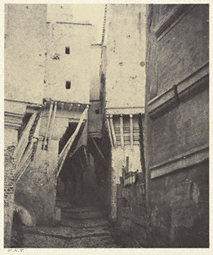
 |
 |
Rue de la Porte Neuve, Algiers, Edward King Tenison, 1867
|
 |
 |
"The peaceful neighborhoods of old Algiers quietly open up and ascend the strange twisting streets, like mysterious staircases all leading up to silence. Private life, as everywhere in the Orient, is protected by impenetrable walls."
—Eugène Fromentin, Une année dans le Sahel (Paris, 1874)
|
 |
 |

 |
 |
Panorama of Algiers, French, c. 1930s
|
 |
"In the Casbah all the modifications, additions, the European bastardizing of the city are diminished by natural screens. One might almost think that no vandalism or ignorant militarism had accompanied colonization. The Casbah is enclosed in such a manner that even the pathways of narrow streets disappear and the world below ceases to exist. All at once it seems that one is no longer connected to the European city."
—Lucienne Favre, Tout l'inconnu de la Casbah (Algiers, 1933)
|
 |
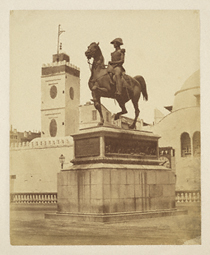
 |
 |
Statue of the Duc d'Orléans, Who Participated in the Conquest of Algiers, Jean-Baptiste Antoine Alary, ca. 1857
|
 |
 |
"O regrets for Algiers and for its stores,
Their traces no longer exist!...
They have rummaged through the tombs of our fathers,
And they have scattered their bones
To allow their wagons to go over them.
O believers, the world has seen with its own eyes.
Their horses tied in our mosques."
—Algerian poem; quoted in Alf Andrew Heggoy, The French Conquest of Algiers, 1830: An Algerian Oral Tradition (Athens, Ohio, 1986)
|
 |
 |
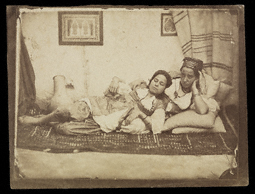
 |
 |
Women of Algiers, circle of Charles Marville, 1858
|
 |
"Meanings of all kinds flow though the figures of women, and they often do not include who she herself is. Women attest the identity and value of someone or something else, and the beholder's reaction is necessary to complete their meaning."
—Marina Warner, Monuments and Maidens (London, 1985)
|
 |
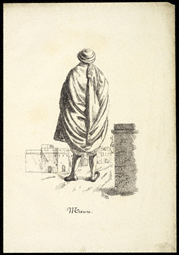
 |
 |
Moorish Man, Vaccari, 1831
|
 |
 |
"Their white city shelters them, almost in the way the burnoose, their national dress, envelops them, in a coarse and unrelieved refuge, a single compact tangle of masonry, built like a tomb, where life unfolds. The Arab thinks he lives in his white city; he buries himself in it."
—Eugène Fromentin, Une année dans le Sahel (Paris, 1874)
|
 |
 |
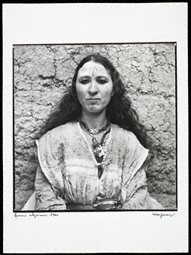
 |
 |
Algerian Woman, Marc Garanger, 1960
|
 |
"In 1960, I was doing my military service in Algeria. The French army had decided that the indigenous peoples were to have a French identity card. I was asked to photograph all the people in the surrounding villages. I took photographs of nearly two thousand persons, the majority of whom were women, at a rate of about two hundred a day. The faces of the women moved me greatly. They had no choice. They were required to unveil themselves and let themselves be photographed. They had to sit on a stool, outdoors, before a white wall. I was struck by their pointblank stares, first witness to their mute, violent protest."
—Marc Garanger, Femmes algériennes 1960 (Anglet, France, 2002)
|
 |







